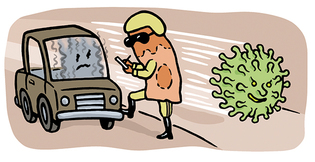 loading
loading
FindingsTaking on the common coldUnderstanding how nasal cells fight rhinovirus.  Gregory NemecView full imageRhinovirus, which causes common colds, can find its way into the nostrils of the most diligent hand-washers. Luckily for us, the body can often fight it off. Exactly how this works has long been mysterious, but a Yale study has uncovered a clue. The study also sheds light on why smokers get more colds. The cells lining our airways can defend against viruses; they can also defend against damage from smoke and other pollutants. But researchers led by Ellen Foxman ’93, an assistant professor of laboratory medicine, found that the cells are specialized. Cells lining the airway have a strong response to viruses; if infected, they release interferon, a protein that alerts other airway cells to guard against infection. If air pollutants enter the airway, the cells activate the protein NRF-2 inside the cell, which triggers the cells to resist damage. For nasal cells, the viral response is stronger than the pollution response. For bronchial cells in the lungs, it’s the opposite. If exposed to both viruses and damaging substances like smoke, cells face a tradeoff. When Foxman’s team exposed nasal cells to chemicals found in cigarette smoke, the cells activated the NRF-2 defense mechanism—which dialed back their virus protection. When the team blocked NRF-2, the cells produced a stronger antiviral response. (The study is in Cell Reports.) But although blocking NRF-2 helped cells fight off rhinovirus in the lab, Foxman says it isn’t a real-world option for curing the common cold. The NRF-2 pathway is crucial for keeping airway cells alive when they face severe stressors like smoke. A drug that blocked NRF-2 would allow those cells to die. But, she adds, the body almost certainly has backup defenses that complement NRF-2. Tracking those down and finding ways to support them might free cells to focus on fending off rhinovirus.
The comment period has expired.
|
|